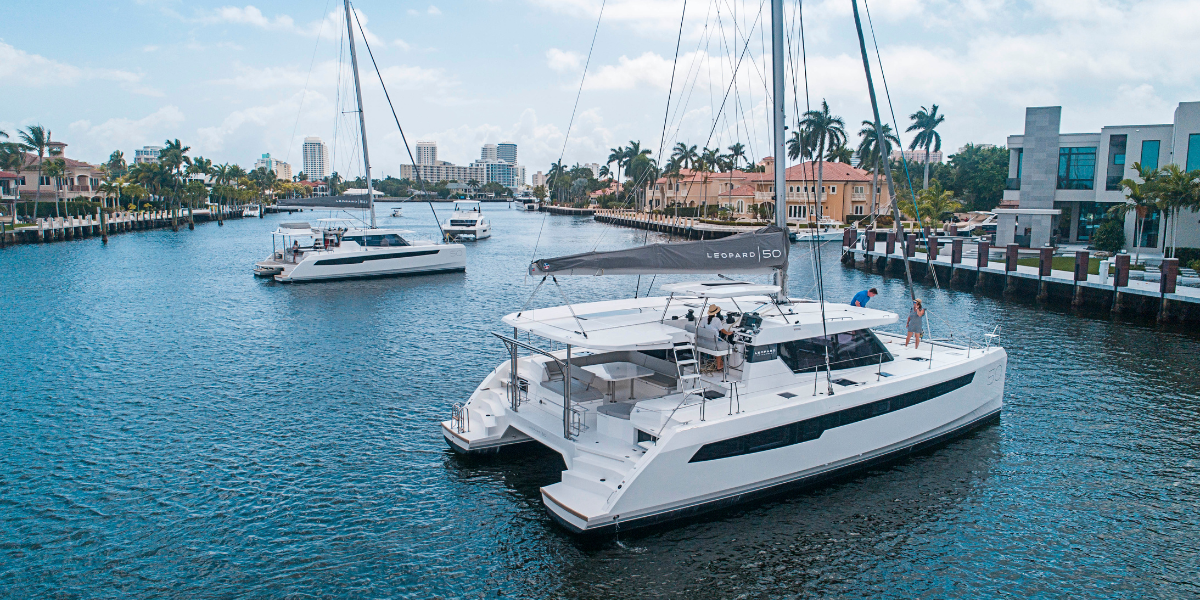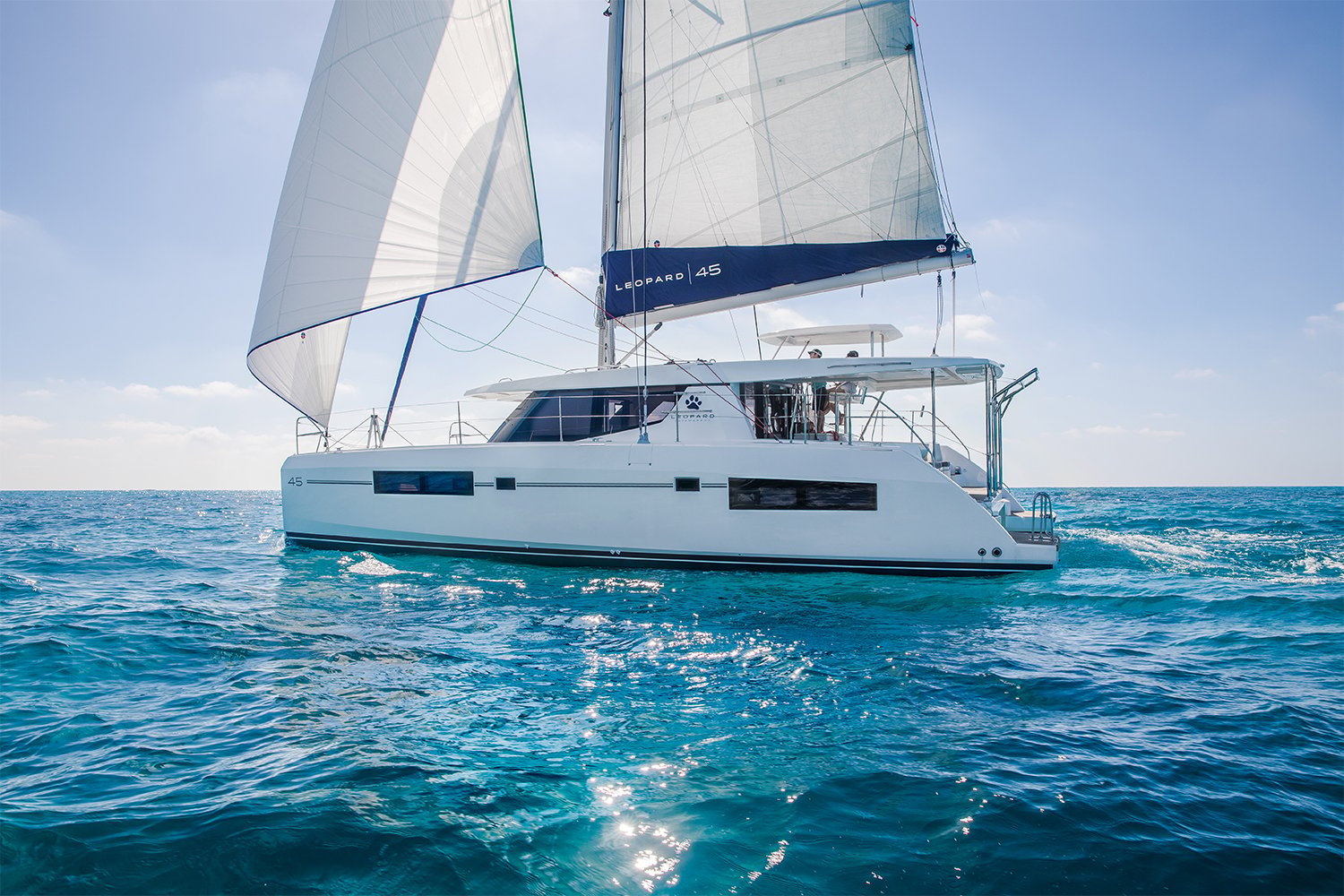Not every minute of boating is created equal. Crossing open stretches of water in your new Leopard is fun and exhilarating. But those first experiences of getting in and out of a slip or marina full of boats, pilings, jetties, shallows (and gawkers) can be, well, a little stressful.
Here are a few pointers to reduce your heart rate when moving about the marina. The basics are the same whether you've got a Powercat or a Leopard sailing catamaran. Follow these guidelines, and, with practice, you'll be able to handle your Leopard comfortably in even the tightest quarters. All it takes is some situational awareness, a few new boat-handling skills, and time at the helm.
-3.png?width=1200&height=600&name=Untitled%20design%20(6)-3.png)
Slow and Steady
The first rule of close-in maneuvers in your catamaran is slow and steady wins the race. A racing engine is the worst sound to hear in a marina — it’s a sure sign that someone has gotten their boat moving too fast and can't compensate. Your Leopard, even when moving slowly, has a lot of momentum and does not respond instantly. So give all your moves plenty of time and be very light with the throttle.
Let Go of the Wheel
When you're moving less than two knots—and you should always move at less than two knots in tight quarters—your rudders do little. They need water moving over them to turn the boat, and two knots is barely enough to make that happen. You get much more turning efficiency with your throttles. So, as you come into the marina, center up the wheel and lock it in place. You will not need it.
Have you ever noticed the nimbleness of bulldozers, bobcats and other tracked vehicles? They have no steering wheels and don't need them. The operator steers entirely with each widely spaced track's forward and back movement. At low speeds, a catamaran moves similarly. Each hull acts like a track, and working them together and against each other gives you complete control of the vessel.
Work Your Engines
Stand at your helm and put one hand on each throttle. Now, stick your thumbs out. Your thumb points in the direction the bow will move if you put that engine in forward and the direction the stern moves in reverse. These are your "tracks" for turning and steering the boat in close quarters. Working the two engines together, you can do anything from spinning in place to negotiating a twisting path through pilings and moored boats.
Using only one engine will turn the boat and give forward or backward motion. But feathering the other engine up in the same direction will slow the turn and speed you up. The engines running at equal speeds in opposite directions will spin your boat in circles or make tight turns. This is something monohull owners only wish they could do!
Mind the Wind and Current
Wind and current almost always influence your catamaran. Pay careful attention to tides and currents, and watch the wind direction and strength as you reach your destination marina or before you leave the slip. Sailing leopards will have more windage than Powercats, but the effects will be about the same.
Check flags and pennants, smokestacks, or even the direction birds are sitting—most gulls prefer to face into the wind. Look for ripples and dark spots on the water, and if you see trees and leaves moving around, expect some wind effects. Similarly, know the tide tables for your marina and whether it has any odd or unusual currents. The wrong wind and current can make getting off a dock or landing lightly challenging.
Approaching docks, slips, and moorings into the wind or current is easier than with the wind at your back. At your back, the wind and current push you forward, making it difficult to control your speed. But these forces act as natural brakes when you are headed into them.
If it's windy when you're getting off the dock, turn your bow out far enough to make it off without getting blown back on. This is often directly into the wind or close to it.
-4.png?width=1200&height=600&name=Untitled%20design%20(5)-4.png)
Important Maneuvers
Learn these maneuvers well enough to execute them without looking at the throttles. The more comfortable you make practiced maneuvers with your eyes directed elsewhere, the better.
Stopping/Spinning/Backing Up
You can stop your Leopard quickly with its reverse gears. Put both engines in reverse at the equal RPMs. Increase power to slow more, but do just what is necessary and start backing up.
To spin your catamaran in place from a dead stop, put one engine in forward and the other in reverse, keeping the power level equal. Note that most propellers have lower thrust in reverse, so the backing engine probably will need to run at slightly higher RPMs than the one in forward.
To back straight, use both throttles at the same level. To swing the stern, apply more RPMs on the engine opposite the direction you want to swing.
Getting Off a Side Tie-Up Dock
For a port-side tie-up, make sure you have a sturdy fender at the aft corner of the hull. Put the port engine in forward while feathering the starboard engine in reverse to keep the boat from moving forward and help swing it out. In proper balance, the boat will rotate away from the dock until you're clear to put both engines forward.\
-3.png?width=1200&height=600&name=Untitled%20design%20(4)-3.png)
Exiting a Slip
Whether you've backed in or gone in forwards, you use a combination of slow, straight pulling out with both throttles, then stop the boat and spin it to point out of the docks.
If you're used to using spring lines to help your boat get off and onto docks, you still can. For example, putting an aft spring to get off on that side tie-up helps you get off the dock using only the starboard engine in reverse instead of feathering the two engines against each other. Do what works for you. There's no right or wrong way.
Practice Makes Perfect
The key to any of this is time at the helm (not the wheel!) practicing each of these maneuvers. Don't start in a tight marina where there are lots of other boats and other obstacles. Find an empty mooring or a pair of empty moorings and execute the necessary maneuvers around them. Put your Leopard through her paces by simulating situations you expect to see inside the marina breakwater.
As with so many things in life, it all comes down to practice, practice, practice.
-3.png?width=1200&height=600&name=Untitled%20design%20(7)-3.png)


